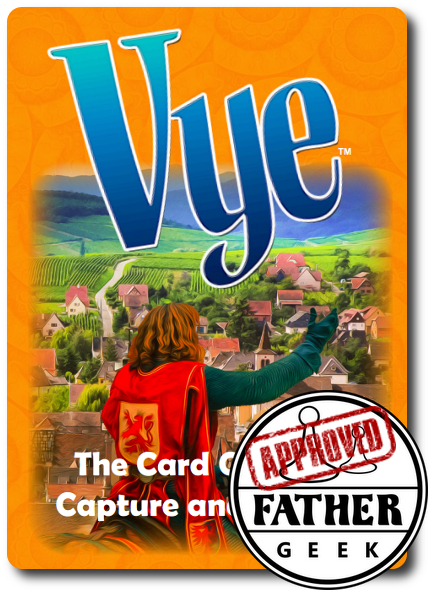
The Basics:
- For ages 5 and up (publisher suggests 8+)
- For 2 to 4 players
- Approximately 20 minutes to complete
Geek Skills:
- Counting & Math
- Logical & Critical Decision Making
- Pattern/Color Matching
- Strategy & Tactics
- Risk vs. Reward
- Visuospatial Skills
- Hand/Resource Management
- Area Control
Learning Curve:
- Child – Easy
- Adult – Easy
Theme & Narrative:
- Expand your small kingdom to rule the realm!
Endorsements:
- Gamer Geek approved!
- Parent Geek approved!
- Child Geek approved!
Overview
Your birthright was a small keep and a few miles of surrounding farmland. But you are an ambitious noble and began to make plans to lift yourself from a small Lordling to a King. But Kings require property, land, and influence. All within reach, but difficult to hold. There are others who thirst for power, too, making your ascension a difficult hill to climb.
Vye, designed by Vince D’Amelio, Joe Morrissey, Doug Woolsey and published by Sixteen Coal Black Horses, is comprised of 36 Land cards, 16 Building cards, 1 Bell Tower card, 2 Stronghold cards, and 80 plastic counters (20 each in the colors red, blue, green, and yellow). The artwork is colorful and the icons use a heraldry-like design that is both informative to the player and complimentary to the game’s theme. Not included with the game, but necessary to play, is a pen or pencil and something to write on to keep track of players’ scores. Also, bring a calculator. You’re going to need it.
Game Set Up
To set up the game, first find and set aside the Bell Tower card and the two Stronghold cards. The Strongholds are only used in a game variant (see “Game Variants” below for details).
Second, each player chooses one of the four counter colors and takes all 20 of the counters of the same color, placing them in front of their sitting position at the table.
Third, select a player to be the first “Dealer”. This player takes the cards, shuffles them, and then deals out 4 cards to each player. Players should keep their cards hidden from their opponents at all times.
Fourth, the Dealer then plays the top 5 cards from the deck to the table, face-up, in a specific order and formation that looks like the following image (the numbers indicate the order in which the cards are placed).
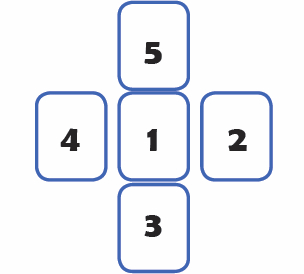
Fifth, the Dealer takes 2 cards from the top of the deck per player and shuffles them with the Bell Tower card. This small pile of cards is then added to the bottom of the deck.
Sixth, the deck is then placed off to one side of the playing area and within easy reach of all the players. This is the draw deck.
That’s it for game set up! The first player is the person directly to the Dealer’s left (going clockwise).
Vying for Control
Vye is played in hands and each hand has no set number of turns. Each hand’s total length is slightly different because the position of the Bell Tower card (which signals the end of the hand) is randomly placed somewhere towards the bottom of the deck. A typical player’s turn is summarized here.
Step 1: Play a Card
The first action the player must do is play a card from their hand. When playing a card, place it face up and position it so that one of its four sides is parallel to at least one other card in play. Diagonal placement is never allowed. Once played, a plastic counter is added to it signifying it’s now owned by that player.
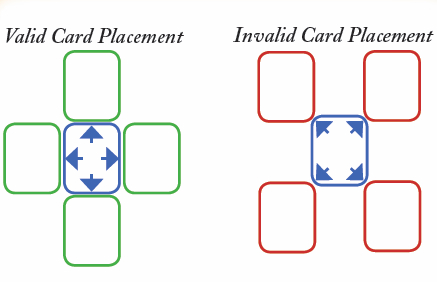
There are two types of cards that can be played. These are Land cards and Building cards. Land cards have an illustration of picturesque scenes ranging from the rich farmlands of the realm, the arid desert region, the turbulent seashore, and the cold north, just to name a few.

The Building cards have an illustration of various structures that are important to sustaining the infrastructure of a kingdom. Specifically, farms, windmills, castles, and citadels. Building cards also contain symbols that look like heraldic banners. These are used as guides when capturing territory.
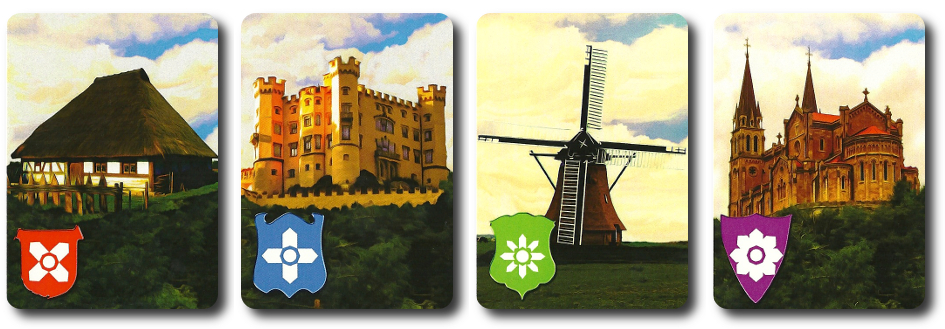
Step 2: Capture Territory
Now the fun begins! When a card is played, there might be an opportunity to capture surrounding territory. Territory is captured two different ways
Capture Through Lands
The most abundant resource and highest number of cards are the Lands. Each Land card has multiple copies of itself in the deck. When two or more Land cards of the same type (with the same illustration) are placed adjacent to each other (never diagonal), this creates a chain. All adjacent Lands that match the same illustration now belong to the player and any counters currently on the newly acquired cards that belonged to the player’s opponents’ are removed and replaced by the player’s counters.
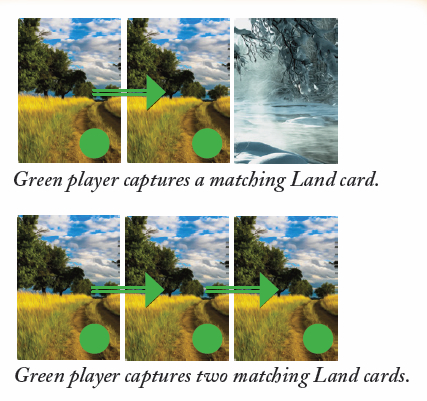
Multiple cards can be captured in this way as long as the chain is not broken by a Land or Building card that does not match the illustration of the Land card just played. Each newly captured Land card is evaluated when determining which adjacent cards can be captured in turn, not just the card that was placed.
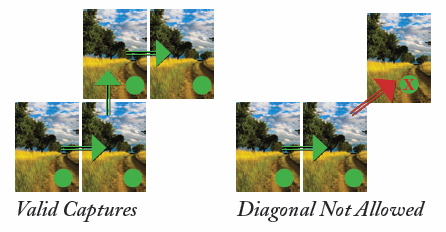
Capture Though Buildings
The Building cards are less frequently found in the deck, but are just as useful when it comes to capturing territory. Buildings do not allow for chains of territory to be captured, but nor do they require the adjacent cards to share the same illustration to be captured. On each of the buildings is a heraldic banner. On the banners are icon images that show in which direction from the center of the Building card territory is captured.
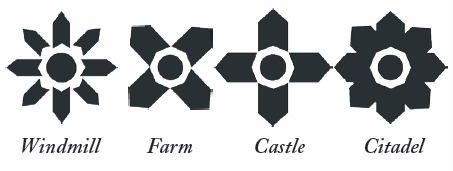
Using the Building cards, players can capture all surrounding territory and even diagonal territory. Just like when capturing territory using Land cards, any previously acquired territory by opponents now belongs the player. But, again, captures through Buildings do not chain. Only the first adjacent card is captured based on the directions provided by the Building card.
Step 3: Draw a Card
The last action taken by the player is drawing back up to 4 cards by taking the top card from the draw deck.
This completes the player’s turn. It’s now the next player’s turn going clockwise.
For Whom the Bell Tolls
The players continue to complete their turns until one player draws the Bell Tower card during step 3 of their turn.

This signifies the end of the hand and each player now tallies points by calculating various scores.
- Kingdom Score: Each player counts how many counters they have on the cards in play. The sum is the player’s Kingdom Score for this hand.
- Victory Score: The player who has the highest Kingdom Score is awarded an additional 50 points to their score. If there is a tie, each tied player receives the 50 points.
- Building Score: Each player earns an additional 10 points to their score for every Building card they control.
- Land Score: Each player earns 5 points for each Land they control.
- Shutout Score: If one player does not control any Building cards, their opponents all receive 50 points.
- Populist Score: If a player wins the hand (has the highest score) and does not control any Building cards, they earn 200 points.
All the points are tallied and the sum is the player’s total score for the hand. These are recorded and the game is reset using the game set up steps above. The first player of the last round is now the Dealer.
Winning Your Crown
The first player to achieve a score of 500 points or more at the end of the round wins the game. If a longer game is needed, play to 1000 points.
Game Variants
- More Players: The base game comes with enough counters for 4 players. More players can be added by simply providing 20 counters of a different color or shape than those already provided. For example, Pennies, Jelly Beans, PEZ…the sky is the limit. It goes without saying that more players equates to a shorter and more chaotic game. Still, it’s always nice to include friends to the game who might have arrived late to the gaming table.
- Color Capture: The normal rules of capturing territory apply. In addition, when a Building card is placed next to another Building card that shares the same color group (two purple icons, for example), the Building card can be captured in addition to whatever other Lands and Buildings would be captured.
- Strongholds: When setting up the game, do not remove the 2 Stronghold cards from play. Strongholds are a specialized Building card, but do not allow for territory capture and two counters are placed on it instead of 1 when played to the table. When the Stronghold would be captured during normal means, one of the two counters are removed, but the Stronghold still remains in the possession of the player. Only when the Stronghold has been captured twice do the counter colors change! Thematically speaking, the Strongholds are so well fortified it takes 2 attempts to take it over. At the end of the game, a player is awarded an additional 20 points per Stronghold they control.

- Empire: The Empire game variant assign each player a specific color as noted on the Building heraldry icons. The players gather the 4 Building cards of their chosen color and place them in front of them, face-up. On the player’s turn, they can play from either their hand or play one Building card they have in front of them. At the end of the game, a player will earn an additional 200 points if they only played their “Citadel” Building card and won the hand.
House Rules
The number of different ways players can earn points was seen as a bit ridiculous and made the game feel a bit more complicated (and heavy) than what it really is. A number of players suggested that the only points that should be counted were the Kingdom and Victory scores. This worked well, made the game a bit longer, but the downtime between hands was significantly shorter. This was found to be a vast improvement and resulted in more fun being had playing the game instead of the less than fun pauses needed to count points. However, by removing the number of different ways a player could earn points, the number of strategic and tactical choices was also reduced.
To learn more about Vye, visit the game’s web page.
Prediction
On the surface, Vye appears to be very much like Robber Knights, another game that is all about controlling territory. There are some startling similarities, actually, but after reading through the rules and seeing the differences in the game components, I don’t think Vye and Robber Knights will feel the same. I’ve said it many times and I’ll say it again: if you play games a lot, you’ll start seeing the same game mechanisms. I should note that similar game mechanisms should not suggest that the game is doppelgänger for two reasons. First, it just so happens that I played Robber Knights before Vye. It could have just as well been the other way around. Second, it’s perfectly responsable and appropriate to reuse the same game mechanisms. There are only so many to go around, after all. For this review, we will ignore any previous experiences with other games and judge Vye on its own merits.
I believe Vye will do very well with all three of our groups. Each group will play the game on different levels, however. For the Child Geeks, the game will be about matching and claiming as much territory as possible. This is the most basic approach to Vye and is essential to victory. The Parent Geeks will take it a bit further and will most likely demonstrate a higher level of game play when it comes to card timing. This is the next level of depth the game provides and will be essential to victory per game hand and ultimately the game itself. The Gamer Geeks should be digging one level deeper and demonstrate card plays that suggest blocking, aggressive area control, and baiting. This is the final level of the game, where the players use the cards like mini countries and the skirmishes on their boarders are won and lost through subtle card play, strategic card placement, and versatile tactical use of the cards to help defend sections of controlled territories.
Exciting!
Teaching the game is very easy with the most effort being focused on the Buildings. Do take the time to demonstrate some of the more involved territory captures with Land cards that can chain through a number of cards. You’ll also want to take a few moments to fully explain the scoring. If the players get upset that they missed points simply because they didn’t understand how some could be earned, the table will quickly sour. Other than that, the game is very straightforward and everyone should be up and playing in no time. Best of all, younger Child Geeks should be able to play at the table with the Parent Geeks all on their own. At most they will need help identifying all the territory they obtain during card placement. We strongly suggest that one person be in charge of the counting of points as it can be rather involved and it’s a lot simpler if just one person do all the addition.
After teaching Vye to my oldest little geeks, I asked them their thoughts on the game so far.
“I like it! A neat card game where I can build my kingdom and take over everyone elses!” ~ Liam (age 8)
“Yep. Same as Liam. I will control it all!” ~ Nyhus (age 5)
My little Lordlings are ready for the challenge of expanding their influence and dominating the competition! Let’s play the game and see if we crown Vye a winner or exile it to the lands of Goodwill.
Final Word
As predicted, the Child Geeks not only had a fun time with Vye, but played the game exactly like I thought they would. Any sense of card timing was completely absent and their entire focus was spent attempting to capture as much territory as possible. This is not a bad strategy, but allows for others to claim territory you have already taken because the only focus is on taking new territory. This also resulted in a very shifty balance of power throughout the entire game and no one knew for certain what the final points were going to be until the very last card was played and the Bell Tower showed up. This made the games surprisingly intense, but never stressful. All the Child Geeks voted to approve Vye and were eager to play another game as soon as the last was over.
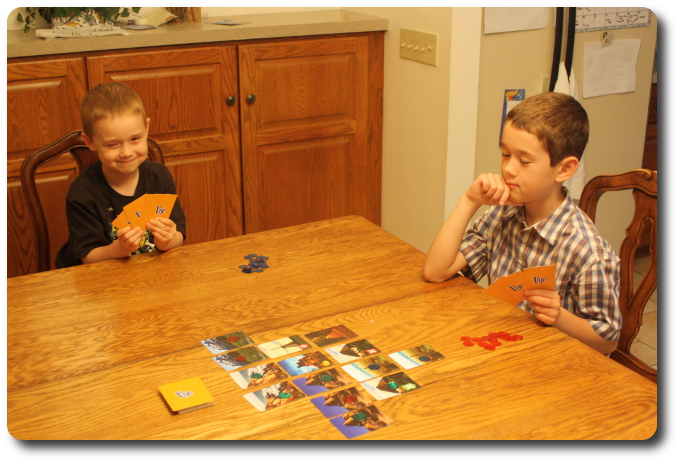
My little Lordlings are having a great time and making me work for my victory
The Parent Geeks also enjoyed Vye, both with their peers and with the family, and demonstrated mixed levels of strategic and tactical game play. They did use card timing in a much more intelligent and tactical manner, but I was also very pleased to see the Parent Geeks use Building Cards to block and break chains. Even the non-gamers were playing strategic and tactically, whether they knew it or not. One Parent Geek said, “This is a great game for whenever and with whomever. A neat concept and a lot of fun to play!” Another Parent geek said, “This is like a war game with a game board but with none of the set up time or complexity.” All the Parent Geeks voted to approve the game and are now asking me to lend my copy out. I told them to buy their own.
The Gamer Geeks, as expected, took Vye to a much deeper level than the Child Geeks and the Parent Geeks. Their plays were exceedingly tactical and it was apparent that each Gamer Geek had a strategy. None of the Gamer Geeks grumbled throughout the game except to state how “displeased” they were when an opponent grabbed a bit of land. Perhaps the best moments of the games were the times when a Gamer Geek would play a Land card that chained a long line of Lands. Oh, how the Gamer Geeks howled with rage or cackled with laughter (depending on who was taking the land or losing it). One Gamer Geek said, “This is a great game for a quick filler or even just sitting down when I want a game but don’t have the time to play something bigger.” Another Gamer Geek said, “There’s a surprisingly lot of depth to this game that I didn’t see before. That was a very pleasant surprise, indeed!” All the Gamer Geeks voted to approve Vye, hated the downtime when scoring, and wanted better counters. Other than that, no problems or concerns.
At present, there are only two items about the game I do not enjoy. The first is the scoring which feels overly labored. Seriously, get out a calculator and prepare to scrutinize the cards like an overly anal accountant. Which brings me to my second item of disappointment. The current counter colors are a bit difficult to distinguish from each other when placed on the cards. For example, red can look a lot like blue on some cards and green and yellow can be exceedingly difficult to tell apart. This makes all the players lean in more than they should be required to when replacing counters due to captures and counting counters at the end of the hand.
Other than that, I really enjoy the game. It’s fast, competitive, and there is a surprisingly deep level of strategy and tactics that can be used when playing. For example, the game forces you to play a card every turn (which you immediately control). The best approach would seem to play a card that allows for multiple captures, but that is not necessarily always the best course of action. There are times where it’s worth trying to “bait” an opponent into taking control of Land so you can chain it to capture more territory. Buildings are also excellent and help capture territories you wouldn’t necessarily be able to take and act as a wall to keep pesky territorial grabbing opponents at bay. Each game I have played, be it with Child Geeks, Parent Geeks, or Gamer Geeks, has always left me wondering if I couldn’t have done more and played harder. You also have to watch the table closely, but I wouldn’t recommend you count the points in your head. That’s a sure way to get a headache and a nosebleed. There’s just too much to score after the hand to make it a viable exercise. Too much shifts and there are simply too many points to count.
Would I recommend Vye? Without hesitation. It’s a fun and highly competitive card game of positioning and timing. I think it’s perfect for game fillers or anytime a card game is a good choice for the table. Child Geeks can play the game without help, Parent Geeks can play the game casually or hardcore, and the Gamer Geeks have always left me feeling bruised and thankful for the beatdown. The only time I didn’t enjoy the game was when someone bumped the table – hard – and the counters were shifted causing us to have to restart the hand. Do play Vye the first chance you get and enjoy the challenge of capturing territory in an ever-shifting land dispute for power and control!
This game was given to Father Geek as a review copy. Father Geek was not paid, bribed, wined, dined, or threatened in vain hopes of influencing this review. Such is the statuesque and legendary integrity of Father Geek.




I feel like it should be obvious, lol, but I really can’t tell: are those illustrations, or photographs with fancy Photoshop filters?
Either way, surprising review! Seems like a great game, and I love how compact it is. If I get it, I’ll definitely add some counters to the order from TGC’s store… maybe some wooden tokens…
Great read!
Much thanks for reading and taking the time to comment, Ben.
Yes, Vye was a “surprising” game, and a pleasant surprise at that.
In response to your question regarding the artwork, I really don’t know. It’s certainly possible that the images are just stylized photographs using Photoshop filters or original illustrations using Photoshop filters. Either way, they work and work well.
And, yes, do get different game bits. I plan on “pimping” my copy as soon as possible.
Ben & Cyrus, my wife pointed me to your comments. I swear, I don’t lurk over comments of my own game 🙂
Hi, I’m Joe Morrissey, one of the creators of Vye. First off, I want to thank you Cyrus for all your kind comments and your amazingly thorough review.
Secondly, we listened to your feedback and are nearly done updating Vye. Gone are those cheap plastic tokens that you didn’t like (we didn’t like them either, but they were cheap). Now they’re replaced with colored wooden cubes, similar to what you’d get in Pandemic. Gone are the overly complex rules for scoring. What were we thinking? Now scoring is very simple. Plus, we’ve completely updated the art and we believe it to be more beautiful and imaginative then the version you played.
Cyrus, we’d really love to send you a copy of the new version to get your thoughts on it. Anyone else interested in seeing the updated version should head over to our Facebook page and check out the photos. Seriously, they won’t disappoint (www.facebook.com/vyegame).
Finally, Ben, thanks for the nice comments. To answer your questions, yes, Doug Woolsey, our artist on the project, took free licensed photos and applied some massive Photoshop filtering to them along with some other ‘artist’ adjustments that I don’t fully understand. We were really happy with how they turned out, initially. They looked great on the screen, but very quickly when playing them we noticed something about them we didn’t like. Some of the cards were hard to tell one from one another, especially if you weren’t playing in a bright room. Add the translucent counters on them and it just didn’t work. So, Doug went back to the drawing board and updated the version that we used during play testing when we first started designing Vye. What you see on the website and the Facebook page is the result of that hard work.
Again, thanks to both of you guys for liking Vye. I hope keep in touch with the game. We’re gearing up for a Kickstarter in a couple months and we’d love to get you guys and anyone else on board.